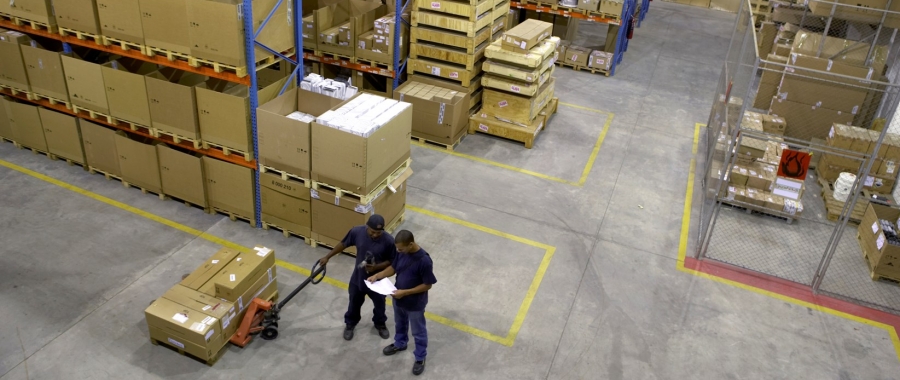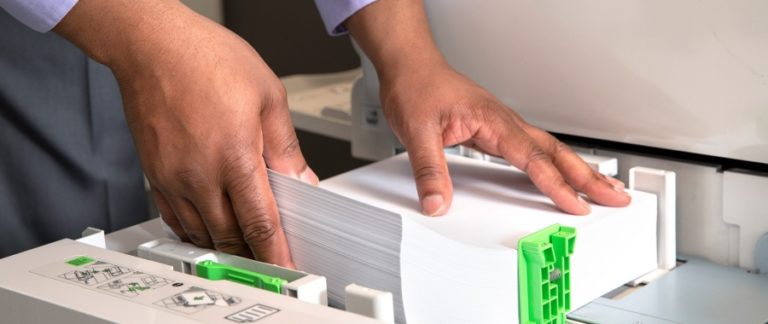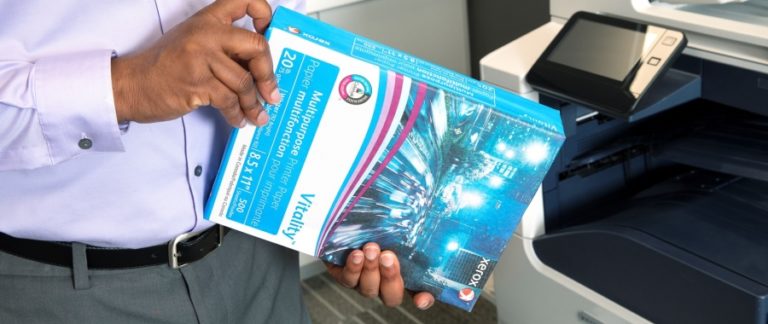This article will present information about the importance of the storage of the paper or media you are using in your printer.
Paper Storage Explained:
Paper is highly sensitive to moisture and the humidity levels within which it is stored. When paper is manufactured, most manufacturers produce paper to strict quality standards including a well regulated level of humidity of between 25-50%. The paper is then carefully sealed into packaging that contains a special lining for maintaining the humidity level of the paper for as long as it is properly stored. It is then loaded into cases and onto wooden pallets with an even surface for shipping to the customer. Paper shipped in this condition is perfect for Xerographic applications, but the freshness of the paper is dependent upon its storage conditions when stored, waiting to be used.
As paper is made of wood fibers, it exhibits similar behavior as other paper products such as paper towel. As a result, paper that is improperly handled or stored, can be subject to excess moisture from the atmosphere, which can cause the paper to increase in size, warp, curl or stick together.
Paper Storage Issues:
Paper with moisture issues can lead to the following issues:
- Damp paper can warp in tray – Paper that has absorbed too much moisture from the atmosphere can begin to become wavy or warp, starting around the edges of the sheet. Warped paper can jam in the paper tray when attempting to feed from the tray, causing a misfeed, and cause wrinkles during the printing process.
- Dry paper can also warp in tray – Paper that has lost too much moisture can contract around the edges of the sheet causing “tight edges”, which can lead to misfeeds, jams, registration issues as well as wrinkles.
- Damp paper can wrinkle in the paper path – Slightly deformed damp paper can lead to paper wrinkling in the paper path. This can result in wrinkled output, paper jams and lines in prints.
- Damp paper can affect Toner bonding to paper – Damp paper can lead to poor Toner application to paper and poor fusing, such as light/faded output, smudging or Toner rubbing off the page.
- Damp paper may Curl – Damp paper may curl more than normal paper would, resulting in curly paper output, or increased instances of misfeeds and paper jams.
- Damp paper may adhere to other sheets – Damp paper may stick to neighboring sheets of paper, becoming difficult to separate and cause misfeeds and jams when multiple sheets of paper are pulled into the printer at once.
Paper Storage Considerations:
- Keep paper in its original packaging until ready for use – Paper is packaged in a wrapper lined with polyethylene plastic that is resistant to moisture and maintains the moisture level of the paper inside the package. Also keep unopened packages of paper stored inside its original cardboard carton whenever possible.
- Carefully handle paper packaging – When transporting or handling cartons or individual reams of paper, be careful to avoid, hitting, denting or dropping packaging as it may deform corners or edges of the paper that are immediately visible. Paper damaged in this manner may increase instances of tray misfeeds and jams.
- Do not store paper on or near the floor – Keep the paper away from environments that experience extreme temperature and humidity shifts and do not store paper flat on the floor as this increases chances of moisture being absorbed into the paper.
- Store paper in a storage cabinet or flat shelf – For paper storage, always keep unused paper in a dry, flat storage cabinet where it can be protected from physical damage and the elements. Always stack the paper evenly on top of the other to avoid curling, bending or damage to the corners of the paper.
- The storage location should be climate controlled – The storage location should also be kept within 68°F/20°C to 76°F/24.4°C and within 35-55% humidity levels for best results. In damp or humid environments, paper, even the paper loaded into the paper trays, can absorb moisture from the air and become too damp to use.
- Paper must be conditioned before use – If the paper cannot be stored in a climate controlled environment or has not been stored this way, the paper must be given a conditioning period before use in accordance to the temperature and humidity levels at which it was stored. For example, a carton of paper stored in a 57.2°F/14°C storage room, brought into a 72.5°F/22.5°C production room must be conditioned for 8 hours before use. The conditioning the time will vary depending upon the temperature difference of the storage area and the number of cartons being used.
- Reseal packages of paper after opening – When opening a new ream of paper and using only a portion of the paper the package contains, reseal the open ream using tape to maintain paper freshness. The packaging contains a special lining that absorbs moisture to help keep remaining paper dry.
- Use only the amount of paper needed in the tray – When loading paper into the printer, load only the amount of paper that the job requires or that will be used in the short term. Paper inserted into the paper trays will absorb moisture from the atmosphere over time, which can lead to the many damp paper issues listed above.
- Store paper in its original package if not being used for an extended period – As paper will absorb moisture from the atmosphere around the printer, if the printer is loaded with too much paper than will be used in the short term, remove the paper from the trays of the printer and back into the original packaging if available.
Join us next time for the final article in our series Paper Facts.




Question, the reason why you don’t have any comments is that you block all of them?
Hi Richard,
Thank you for reading the blog. We do not block comments unless they are spam.
Thanks,
CherylO-Xerox
My apologies for the previous post! You did post my comments. Thanks
Hi Richard,
You are welcome.
Thanks,
CherylO-Xerox